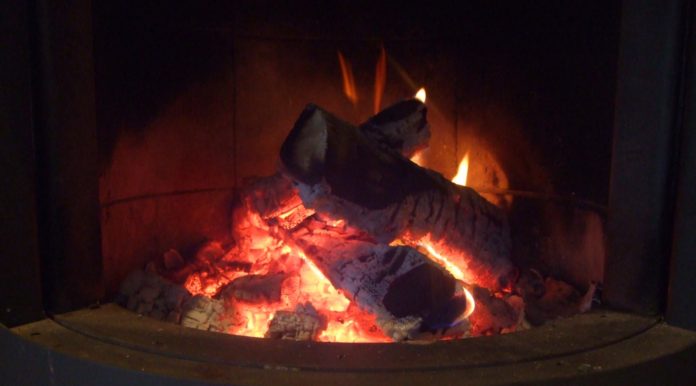There are 3 basic reasons why you should get your chimney swept
1) To protect your health, Breathing in the fumes from gas or solid fuel fires can cause serious damage to your health and in the worse cases prove fatal. Having your chimney swept will help make sure that the flue is sufficiently clear to allow the dangerous fumes to escape safely out of the chimney. Accidental carbon monoxide poisoning from burning wood in the fireplace; Breathing the fumes from gas or solid fuel fires can be dangerous or, in some cases, fatal.
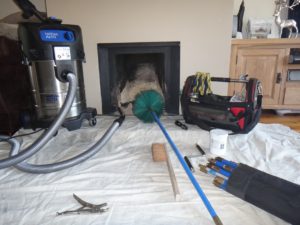 Carbon monoxide (CO) is produced whenever fuel is burned. Even at low levels, CO can cause headaches, dizziness, nausea, confusion and fainting. A blocked chimney or a chimney with an improperly functioning flue can cause a buildup of this dangerous gas. CO is responsible for thousands of deaths in America each year, and many of these poisonings are caused by blocked chimneys. This is why it is critical to have your chimney examined and swept to make sure your flue is clear before using the chimney.
Carbon monoxide (CO) is produced whenever fuel is burned. Even at low levels, CO can cause headaches, dizziness, nausea, confusion and fainting. A blocked chimney or a chimney with an improperly functioning flue can cause a buildup of this dangerous gas. CO is responsible for thousands of deaths in America each year, and many of these poisonings are caused by blocked chimneys. This is why it is critical to have your chimney examined and swept to make sure your flue is clear before using the chimney.
2) To avoid chimney fires, Having your chimney swept regularly will drastically reduce the chances of having a chimney fire. Chimney fires can cause property damage the least usually being a cracked chimney pot. Which will need to be replaced and the worst being you could lose your home! Fortunately, the more extreme outcome does not happen very often, but it does happen.
Trust us—you DO NOT want a fire in your chimney. A chimney fire can be quite spectacular—with loud popping and cracking sounds, lots of dense smoke and a strong, hot odor. But chimney fires aren’t always dramatic enough to alert the neighbors. Sometimes, they burn slow and aren’t even visible, but they still reach high temperatures and can seep into the walls of your house and ignite anything flammable. Flames from a chimney fire can quickly spread into the walls or onto the roof of your home and cause massive devastation, if not the total destruction of your home. It is a nightmare scenario, but one that can most likely be avoided with proper care and maintenance of your chimney.The most common cause of chimney fire is, simply, a dirty chimney. Over time, chimneys will become clogged with creosote, a natural, tar-like substance that is a by-product of burning wood. Creosote is black or brown in appearance and, over time, it builds up and leaves a glazing inside your chimney. This glazing is highly combustible and it can take only a small amount to start a fire. Restricted air supply is one of the factors that contribute to the build up of creosote, another reason it is important to clean your chimney regularly.
3) To avoid smoke damage. Each time the fire is used, soot will accumulate up the chimney. Gradually, this will decrease the size of the flue which in turn, will lower the draw of the smoke upwards. If the chimney does not have enough pull, the smoke will enter into the room, not only causing irritation to you, but can also blacken your fireplace or the decoration above.
When a chimney is not regularly cleaned, soot will accumulate around the flue. This makes it difficult for the flue to draw the smoke upwards and can cause the smoke to enter your room. This soot will leave a black film around your hearth and soil any furniture, carpeting or decorations nearby. Sometimes, smoke can even cause black staining around your chimney, which can be difficult or impossible to remove.
How often do I need my chimney or woodburner swept?
This depends on how often the fire is used and what you burn. A general guideline is, For occasional evening and weekend use, Once a year is enough. For more frequent use, you should have your fire swept once before you start having fires then once again half way though the burning season. Some people also have it swept at the end of the winter season, to prevent any dust falls into the house during the summer.
Can the chimney be cleaned properly with just a vacuum?
No a vacuum is used to suck up soot that falls when sweeping the chimney. Brushes must be used to sweep the soot from inside the stack.
How long does it take to sweep a chimney?
It takes around 45 minutes from start to finish to sweep the average chimney. If your chimney sweep is in and out within a short period of time he is not doing the sweep properly.
I have a gas fire, do I still need the chimney swept?
You should have your gas appliances checked and serviced regularly by a corgi registered engineer. This should be done yearly or more often if a problem occurs. At the time of the service, the engineer will check the draw of the chimney and, if there is a problem sweeping the chimney will almost certainly be necessary.
Why does my chimney smoke?
There are different reasons why your chimney may smoke. Below is a list of the major causes. It may be that only one or a combination of any of them could cause the smoke to blow back into the room.
Blocked chimneys
Having the chimney swept will either correct the problem or highlight where and what the blockage could be. The chimney sweep can the advise on what work will then be necessary.
Cold air up the chimney
If the fire hasn’t been lit for a while, the air up the chimney can get cold. Cold air is heavy and if the flue isn’t heated quickly enough, the cold air will force the smoke back into the room. Initially, just burn newspaper as this will create a lot of heat quickly and will move the air upwards.
Downdraught
Downdraught is a brief flow of air down the chimney resulting in puffs of smoke interfering with the wind flow. To help with this problem, a cowl can be fitted on the pot. It is advisable to ask your chimney sweep which type of cowl to use as there are many different designs suited for the different problems. If the incorrect cowl is fitted, it may make the problem worse being pushed back into the room. One reason for downdraught is that the chimney stack has been built to short and another could be trees, buildings or other large high objects.
Inadequate ventilation
All fires need air to make them burn properly. A lot of properties are very well insulated with double glazing etc. thus not allowing a flow of replacement air into the room. This can be solved by fitting air vents or simply leaving the door to the room open.
The wrong sized fireplace
The average size fireplace opening is about 18″ wide and 24″ high. If it exceeds this by a large amount, some of the smoke may curl out into the room. Try either lifting the grate up or lowering the height.
How can I stop birds nesting?
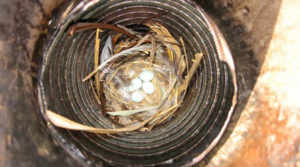 Birds nesting can be a big problem. More so the nearer you get to the countryside. There are companies who make purpose built bird guards. These should always be used in preference to putting chicken wire on the pot. Proper bird guards are strong enough to withstand any efforts from the birds to pull them off. They do not reduce the size of your chimney pot in any way. (which is important for the draw of your chimney.
Birds nesting can be a big problem. More so the nearer you get to the countryside. There are companies who make purpose built bird guards. These should always be used in preference to putting chicken wire on the pot. Proper bird guards are strong enough to withstand any efforts from the birds to pull them off. They do not reduce the size of your chimney pot in any way. (which is important for the draw of your chimney.
Can I sweep my own chimney?
There is nothing wrong with cleaning your own chimney, but you must ask yourself is it worth it. I have been called out on many occasions to get lost brushes out of peoples chimneys and been told many stories of mess and soot covered houses made by people sweeping their own chimneys. If you still want to clean your own chimney you will need a selection of brushes that are suitable for your chimney and a set of lock fast rods, these are used so they don’t unscrew. You will also need a high powered vacuum that is made to catch all the fine particles of soot. Please don’t use you home vacuum as you will probably blow soot all around your home. The total cost of all of this equipment is around 1500 Euros, which is not cost effective as a chimney sweep is 50 to 60 Euros.
Can I burn wet or unseasoned wood?
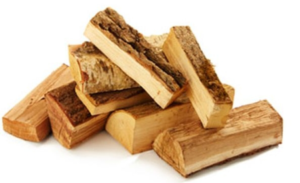 You should never burn wet or unseasoned wood the main reason for this is as the gases rise up your chimney stack, the moister in the gases condensate on the inner walls of the chimney stack and set as a hard tar. This is in most cases will not be able to be removed and if built up could catch fire and lead to a large chimney fire. Burning wet would gives little heat and may spit sparks into the room. You can avoid this by buying a moisture meter, this way you can reject damp wood, the wood should not have a moisture of over 25% anything higher will start leading to problems.
You should never burn wet or unseasoned wood the main reason for this is as the gases rise up your chimney stack, the moister in the gases condensate on the inner walls of the chimney stack and set as a hard tar. This is in most cases will not be able to be removed and if built up could catch fire and lead to a large chimney fire. Burning wet would gives little heat and may spit sparks into the room. You can avoid this by buying a moisture meter, this way you can reject damp wood, the wood should not have a moisture of over 25% anything higher will start leading to problems.
What are the benefits of a wood burner over a open fire?
More and more people are realising the benefits of having a stove fitted instead of a open fire. The reasons for this is a stove is far more efficient uses less fuel and gives much more heat in to the room. The average open fire when lit is around 20% efficient this mean that 20% of the heat created comes out into the room and 80% goes up the chimney and out of the house. Where as a good stove can be up to 90% efficient that is 90% of the heat coming back into the room and only 10% going up the chimney stack. The other down side to a open fire is that when your not using the open fire, heat from the house is still rising up the chimney and out of the house and cold air is then brought back in to the house from outside to replace it by the way of draughts. You can lose up to 40% off your central heating this way. With a stove you can close the doors and shut the vents so warm air is not being lost up the chimney when not in use.
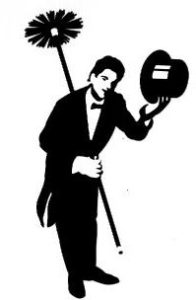 Charlie (Sweep)
Charlie (Sweep)
(00357) 97 63 60 60








